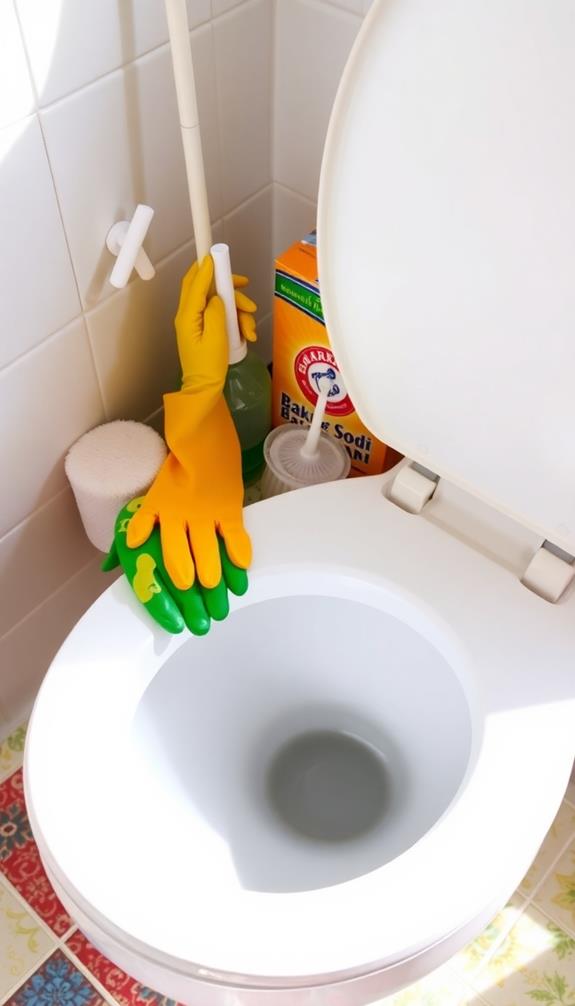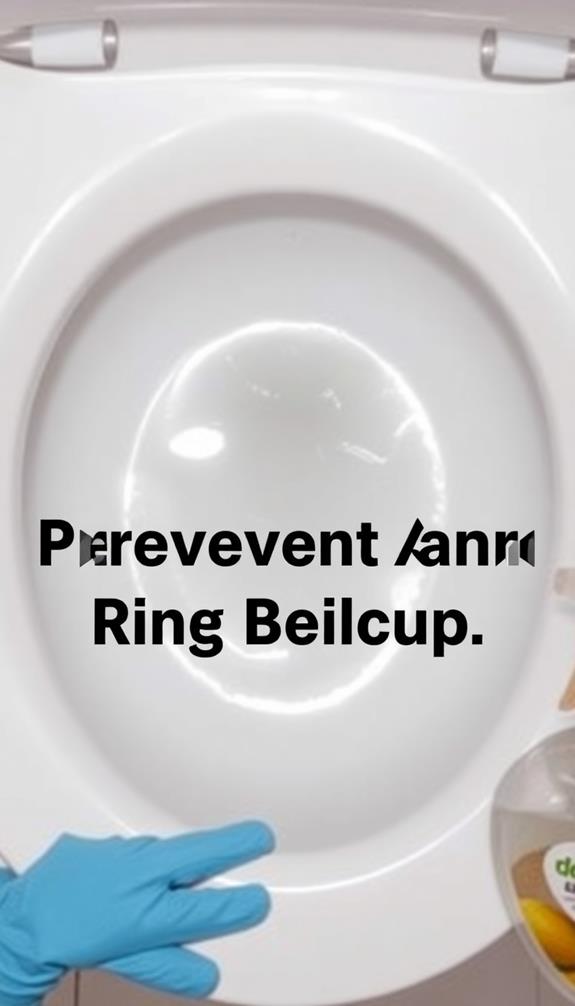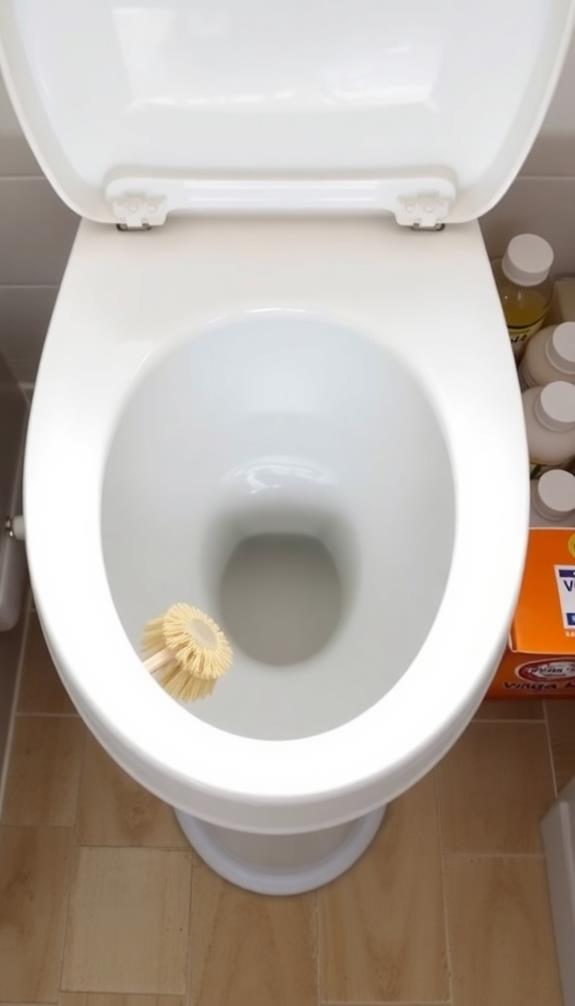To clean that pesky ring in your toilet, start by pouring one cup of distilled white vinegar into the bowl. Next, sprinkle half a cup of baking soda and let the mixture fizz for five minutes. After that, grab a silicone toilet brush and scrub the ring thoroughly. Flush to rinse it all away. For stubborn stains, a pumice stone or a commercial cleaner can do wonders. Remember, regular cleaning not only keeps your toilet looking good but also prevents bacteria buildup. Keep exploring for even more tips and techniques to keep your bathroom fresh and clean!
Understanding Toilet Bowl Rings
When it comes to understanding toilet bowl rings, it's vital to recognize their primary causes. Toilet bowl rings typically form due to mineral deposits from hard water, including calcium, iron, and magnesium. These minerals can create brown or green stains at the water line that are unsightly and difficult to remove.
Additionally, bacteria like Serratia marcescens thrive in damp environments, leading to pink or light orange rings in your toilet bowl. Regular disinfection lowers the risk of infections and illnesses. The design of some toilet bowls may trap debris, making them more prone to these stains and providing a breeding ground for mold and bacteria.
Furthermore, environmental factors such as water quality and the frequency of flushing greatly influence the development of toilet bowl rings. Stagnant water, for instance, promotes mineral buildup, exacerbating the issue.
To combat these problems, maintaining a regular cleaning routine is vital. By incorporating effective toilet cleaning practices, you can minimize the accumulation of both mineral deposits and bacteria.
A proactive approach will help keep your toilet bowl looking fresh and prevent the formation of hard water stains and unsightly rings.
Essential Cleaning Supplies
Cleaning a toilet bowl effectively requires the right supplies to tackle those stubborn rings. Start with baking soda and vinegar; these two natural ingredients create a powerful cleaning reaction when combined. They not only help in breaking down stains but also freshen up your toilet.
Incorporating non-toxic cleaning solutions like these guarantees that you can maintain a hygienic bathroom without compromising your family's health.
You'll also want a pumice stone in your cleaning arsenal. It's excellent for scrubbing away tough stains without scratching the toilet bowl's surface, making it a safe choice for regular use.
Pair this with a durable silicone toilet brush, which can easily reach all areas of your toilet bowl and provide a thorough scrub.
Don't forget to wear rubber gloves during the cleaning process. They're essential for maintaining hygiene and protecting your hands from germs and harsh cleaning agents.
If you prefer commercial options, products like Bar Keepers Friend and Lime-A-Way can effectively tackle tough toilet stains and mineral deposits.
With these essential cleaning supplies, you'll be well-equipped to say goodbye to those unsightly toilet bowl rings and maintain a sparkling clean toilet.
Step-by-Step Cleaning Process

Now that you have your cleaning supplies ready, it's time to tackle that toilet ring with a straightforward step-by-step process.
Start by pouring one cup of distilled white vinegar into the toilet bowl. This will help break down stains and mineral deposits. To enhance the cleaning power, consider using a natural scrubbing paste made from baking soda and vinegar.
Next, sprinkle half a cup of baking soda into the bowl. You'll notice a fizzing reaction, which is great for lifting stubborn stains.
Allow the vinegar and baking soda mixture to sit for five minutes. This waiting period maximizes the cleaning effect, so don't skip it!
After the time's up, grab your silicone toilet brush and start to scrub the toilet ring thoroughly. Focus on the areas with visible stains, applying a bit of elbow grease to really get in there.
Once you've scrubbed the toilet well, it's time to flush the toilet. This will rinse away the cleaning mixture along with any loosened debris, leaving your bowl clean and fresh.
With just a bit of effort, you've tackled those pesky stains and made your toilet shine!
Advanced Techniques for Stubborn Stains
For those persistent toilet rings that refuse to budge, advanced techniques can make all the difference. Start by using a pumice stone toilet cleaner. Wet the stone and gently buff away the stains in toilet bowls. This method is effective against mineral deposits without scratching the porcelain.
Additionally, natural cleaning methods like using baking soda and vinegar can be highly effective for regular maintenance and stain removal.
Next, try a mixture of baking soda and vinegar into the toilet. Pour about a cup of baking soda followed by two cups of vinegar. Let this cleaning agent sit for at least 30 minutes to create a powerful reaction that loosens tough stains. Afterward, scrub with a toilet brush for best results.
If those methods don't work, consider applying a commercial cleaner like Lime-A-Way, specifically designed for hard water stains. Alternatively, soak the toilet bowl with oxygen bleach overnight. This will help dissolve stubborn stains, making it easier to scrub them away come morning.
Prevention Techniques

To keep toilet rings at bay, you should establish a regular cleaning schedule, ideally tackling it once a week.
Installing a water softener can help reduce mineral buildup, making your job easier.
Plus, using proper flushing techniques guarantees that waste is cleared effectively, preventing residue from forming.
Regular Cleaning Schedule
Establishing a regular cleaning schedule is essential to keeping toilet bowl rings at bay. Aim to clean your main bathrooms at least once a week and guest bathrooms every other week. This routine considerably reduces the buildup of tough stains, especially if you live in an area with hard water.
Incorporating a brief daily maintenance routine can also help. Just grab your toilet brush and give the area around the water line a quick scrub to prevent stains and debris from accumulating.
Additionally, consider using a toilet tank cleaner; it helps minimize mineral deposits and can reduce how often you need to deep clean.
Proper flushing techniques are vital, too. Make sure you flush adequately to clear waste and avoid any residue that could lead to staining.
Finally, always keep the toilet lid closed when not in use. This simple step helps reduce moisture in the bowl, inhibiting the growth of bacteria and mold that contribute to ring formation.
Water Softener Installation
Installing a water softener is one of the most effective ways to tackle the problem of toilet bowl rings. Hard water contains minerals that lead to stubborn stains and can create a never-ending cleaning cycle. By opting for a water softener installation, you replace those hard minerals with sodium ions, greatly improving your water quality.
Here's what you can look forward to with a water softener:
- Reduced toilet bowl rings, making your cleaning routine less of a chore.
- Extended lifespan of appliances, saving you money on costly replacements.
- Less frequent cleaning, giving you more time for the things you love.
A typical installation costs between $800 to $2,500, but it pays off in the long run by minimizing plumbing repairs and lowering your cleaning frequency.
Regular maintenance, like salt replenishment, is essential to keep the system running efficiently. By investing in a water softener, you not only improve the appearance of your toilet but also enhance the overall quality of your home's water.
Say goodbye to those pesky toilet bowl rings and hello to a cleaner, easier lifestyle!
Proper Flushing Techniques
After addressing hard water issues with a water softener, maintaining your toilet's cleanliness also relies on proper flushing techniques.
Always guarantee the toilet is flushed completely after each use to prevent waste and mineral buildup from lingering in the bowl. This buildup can lead to stubborn rings that are difficult to remove.
If your toilet has a dual flush option, use a full flush for solid waste and a partial flush for liquid waste. This effectively clears the bowl and reduces residue accumulation.
Regularly check the flapper and fill valve to confirm your toilet flushes properly. Ideal water levels are essential for effective cleaning.
Avoid flushing anything other than toilet paper and human waste, as this decreases the likelihood of clogs and unwanted debris that can contribute to staining.
Health and Hygiene Considerations
When it comes to maintaining a clean bathroom, health and hygiene considerations should be at the forefront of your mind. Toilet bowl rings aren't just unsightly; they can harbor harmful bacteria that increase your risk of infections.
Regular cleaning is essential for minimizing the buildup of mold and mildew, which can trigger allergies and respiratory issues for sensitive individuals. Utilizing reliable cleaners and establishing a consistent cleaning routine can help you maintain a germ-free environment, ensuring a healthier bathroom space for you and your family effective cleaning techniques.
Consider the following points:
- Hygiene: A dirty toilet can compromise overall bathroom hygiene.
- Odors: Stains and rings contribute to unpleasant odors, creating an unwelcoming environment.
- Mental Well-Being: A clean space fosters a sense of peace and comfort.
Expert Tips for Maintenance

To keep your toilet ring-free, establish a regular cleaning schedule, ideally every week.
Consistency in this routine not only boosts the effectiveness of your cleaning efforts but also enhances the overall hygiene of your bathroom.
Make sure you're also using proper flushing techniques to clear waste effectively and reduce residue buildup.
These simple practices can make a big difference in maintaining a clean and hygienic bathroom, as they contribute to daily routines that provide stability.
Regular Cleaning Schedule
Establishing a regular cleaning schedule is essential for keeping your toilet ring-free and maintaining a hygienic bathroom environment. Ideally, you should clean your primary bathroom once a week and guest bathrooms every other week. This routine helps prevent the buildup of stubborn toilet bowl rings.
Incorporating daily maintenance routines can also make a significant difference. Just a quick 30-second brush around the water line with a toilet brush to scrub can mitigate stains before they become an issue.
Consider these emotional benefits of a consistent cleaning schedule:
- Enjoy a fresher bathroom experience every time you use it.
- Reduce unpleasant odors that can linger due to neglect.
- Create a welcoming environment for guests, enhancing their comfort.
Additionally, using toilet tank cleaners or installing a water softener can help combat hard water issues that lead to mineral deposits.
Regularly monitor your toilet's condition to catch any problems early, and educate everyone in your household about proper toilet use and maintenance practices. This proactive approach promotes a cleaner bathroom and helps you avoid stubborn stains in the long run.
Proper Flushing Techniques
Although it might seem simple, mastering proper flushing techniques can greatly impact your toilet's cleanliness and help prevent unsightly rings. A strong flush is essential for removing waste effectively, so use the toilet handle firmly and consistently. This guarantees that lingering debris is cleared away, reducing the likelihood of stains forming in the toilet bowl.
Regularly check for any issues, like a weak flush or water retention, which can lead to residue buildup and contribute to toilet rings. If you notice problems, address them promptly to maintain peak flushing performance.
Encourage everyone in your household to flush the toilet after each use, reinforcing the importance of cleanliness and minimizing the risk of stains developing over time.
If you're still struggling with toilet bowl rings, consider upgrading to a toilet with a more efficient flushing design. These models often reduce water retention, helping to prevent the accumulation of mineral deposits that cause unsightly stains.
Additional Cleaning Methods
Sometimes, traditional cleaning methods just don't cut it when it comes to stubborn toilet rings. If you're tired of seeing those unsightly stains, try these additional methods to clean your bowl effectively.
Here are some creative approaches that can help you remove those pesky stains: Incorporating natural solutions into your cleaning routine can be both effective and eco-friendly, helping to promote a healthier indoor environment while tackling tough stains eco-friendly stain removal.
- Lemon Kool-Aid: Sprinkle a packet over the ring, let it sit for an hour, then scrub and flush.
- Dryer Sheets: Use a used dryer sheet to scrub the stains; its texture makes lifting stains easier.
- Borax and Vinegar: Sprinkle borax into the bowl, add vinegar, and watch the cleaning reaction work its magic.
For even more effortless solutions, consider dropping a dishwasher pod into the toilet bowl overnight to dissolve mineral deposits.
You can also apply oxygen whitener to stubborn stains and let it sit overnight for enhanced results.
With these methods, you'll be well-equipped to tackle those tough stains and keep your toilet looking fresh and clean.
Don't let stubborn rings ruin your bathroom's appearance—try these innovative solutions today!
Conclusion
Cleaning a toilet bowl ring doesn't have to be an intimidating task. With the right supplies, a clear process, and a few expert tips, you can tackle those stains effectively. By maintaining your toilet regularly, using preventive measures, and applying advanced techniques when needed, you'll keep your toilet fresh and clean. So, roll up your sleeves, grab your tools, and commit to a cleaner, healthier bathroom. You'll feel proud, you'll save time, and you'll enjoy a sparkling toilet!